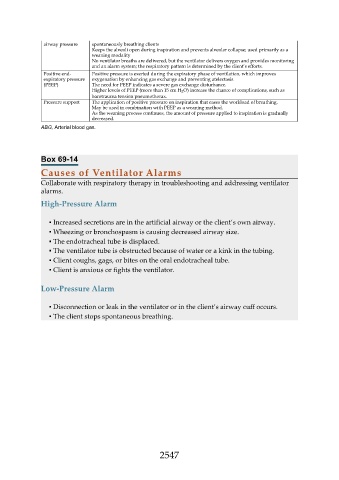Page 2547 - Saunders Comprehensive Review For NCLEX-RN
P. 2547
airway pressure spontaneously breathing clients
Keeps the alveoli open during inspiration and prevents alveolar collapse; used primarily as a
weaning modality
No ventilator breaths are delivered, but the ventilator delivers oxygen and provides monitoring
and an alarm system; the respiratory pattern is determined by the client’s efforts.
Positive end- Positive pressure is exerted during the expiratory phase of ventilation, which improves
expiratory pressure oxygenation by enhancing gas exchange and preventing atelectasis.
(PEEP) The need for PEEP indicates a severe gas exchange disturbance.
Higher levels of PEEP (more than 15 cm H 2 O) increase the chance of complications, such as
barotrauma tension pneumothorax.
Pressure support The application of positive pressure on inspiration that eases the workload of breathing.
May be used in combination with PEEP as a weaning method.
As the weaning process continues, the amount of pressure applied to inspiration is gradually
decreased.
ABG, Arterial blood gas.
Box 69-14
Causes of Ventilator Alarms
Collaborate with respiratory therapy in troubleshooting and addressing ventilator
alarms.
High-Pressure Alarm
▪ Increased secretions are in the artificial airway or the client’s own airway.
▪ Wheezing or bronchospasm is causing decreased airway size.
▪ The endotracheal tube is displaced.
▪ The ventilator tube is obstructed because of water or a kink in the tubing.
▪ Client coughs, gags, or bites on the oral endotracheal tube.
▪ Client is anxious or fights the ventilator.
Low-Pressure Alarm
▪ Disconnection or leak in the ventilator or in the client’s airway cuff occurs.
▪ The client stops spontaneous breathing.
2547

